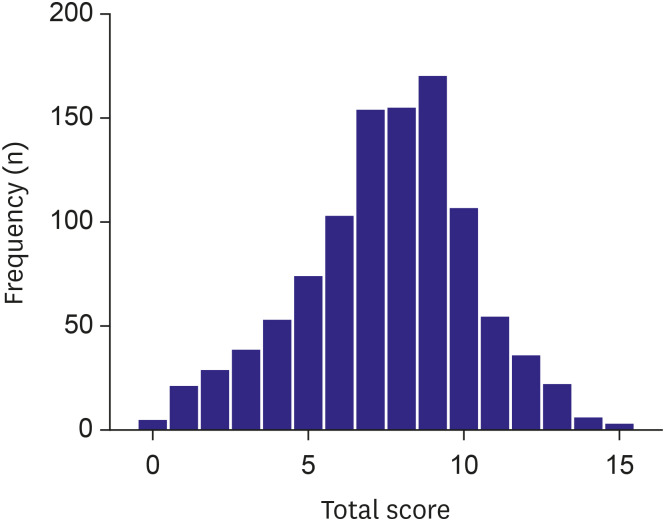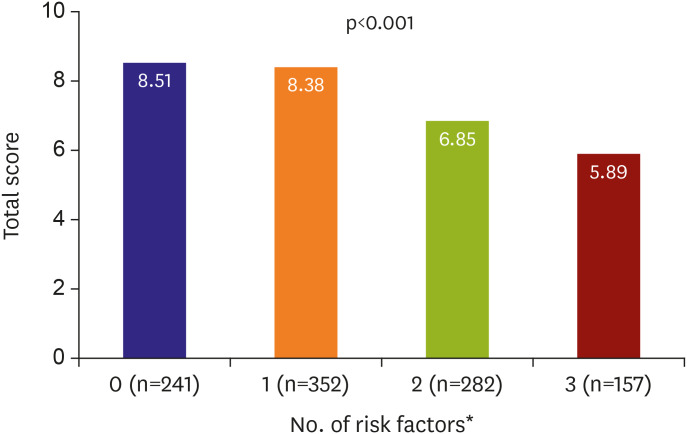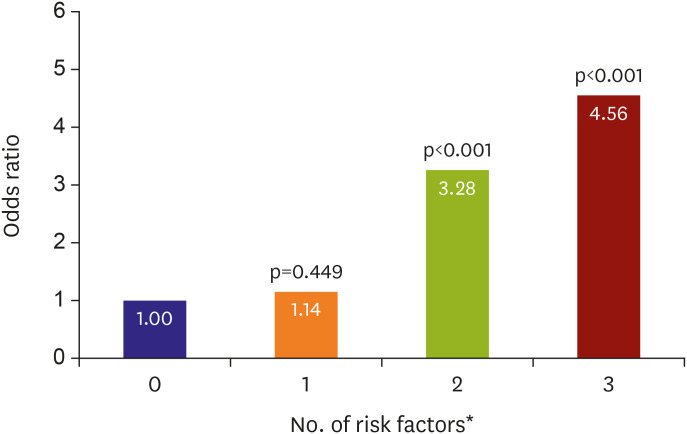Korean Circ J.
2020 Jul;50(7):586-595. 10.4070/kcj.2019.0401.
Factors Associated with Low Awareness of Heart Failure in the General Population of Korea
- Affiliations
-
- 1Division of Cardiology, Seoul Metropolitan Government-Seoul National University Boramae Medical Center, Seoul National University College of Medicine, Seoul, Korea
- 2Division of Cardiology, Dongtan Sacred Heart Hospital, Hallym University College of Medicine, Hwaseong, Korea
- 3Division of Cardiology, Soonchunhyang University Bucheon Hospital, Bucheon, Korea
- 4Division of Cardiology, Korea University Guro Hospital, Korea University College of Medicine, Seoul, Korea
- 5Department of Thoracic and Cardiovascular Surgery, Heart Vascular Stroke Institute, Samsung Medical Center, Sungkyunkwan University School of Medicine, Seoul, Korea
- 6Division of Cardiology, Kosin University Gospel Hospital, Kosin University College of Medicine, Busan, Korea
- 7Division of Cardiology, Seoul National University Bundang Hospital, Seoul National University College of Medicine, Seongnam, Korea
- KMID: 2504217
- DOI: http://doi.org/10.4070/kcj.2019.0401
Abstract
- Background and Objectives
Factors associated with low heart failure (HF) awareness have not been well-evaluated. This study was conducted to find out which demographic features would be associated with low HF awareness in the general population of Korea.
Methods
A telephone interview was conducted with 1,032 adults (58 years and 50.6% were male) across the country. Based on answer to 15 questions about HF, we scored from 0 to 15 points (mean, 7.53±2.75; median, 8; interquartile range, 6–9). A score of <8 was defined as low HF awareness, and a score of ≥8 was defined as high HF awareness.
Results
A total of 478 subjects (46.3%) had low HF awareness. HF awareness scores were 5.18±1.85 and 9.55±1.50 in subjects of low and high HF awareness groups, respectively. Subjects with low HF awareness were older, more female-dominant, more diabetic, lower educational and house hold income levels, and more frequently living in rural areas, compared to those with high HF awareness (p<0.05 for each). In multivariable logistic regression analyses, older age (≥67 years: odds ratio [OR], 1.61; 95% confidence interval [CI], 1.16–2.19; p=0.004), female sex (OR, 1.33; 95% CI, 1.02–1.73; p=0.034) and low educational level (high school graduate or less vs. college graduate: OR, 2.38; 95% CI, 1.75–3.22; p<0.001) were significantly associated with low HF awareness even after controlling for potential confounders.
Conclusions
Older age, female sex, and lower level of education were independently associated with low HF awareness in the general Korean population. More attention and education are needed for these vulnerable groups to improve HF awareness.
Keyword
Figure
Cited by 1 articles
-
Heart Failure Awareness in the General Population: What Should We Do Next?
Myung-A Kim
Korean Circ J. 2020;50(7):596-598. doi: 10.4070/kcj.2020.0165.
Reference
-
1. Jackson SL, Tong X, King RJ, Loustalot F, Hong Y, Ritchey MD. National burden of heart failure events in the United States, 2006 to 2014. Circ Heart Fail. 2018; 11:e004873. PMID: 30562099.
Article2. Murad K, Goff DC Jr, Morgan TM, et al. Burden of comorbidities and functional and cognitive impairments in elderly patients at the initial diagnosis of heart failure and their impact on total mortality: the Cardiovascular Health Study. JACC Heart Fail. 2015; 3:542–550. PMID: 26160370.3. Laribi S, Aouba A, Nikolaou M, et al. Trends in death attributed to heart failure over the past two decades in Europe. Eur J Heart Fail. 2012; 14:234–239. PMID: 22237388.
Article4. Chakraborty A, Chatterjee S. Convergence in findings from randomized trials and elaborately analysed observational data on mortality reduction with carvedilol in heart failure in comparison with metoprolol. Eur J Heart Fail. 2014; 16:595–597. PMID: 24863629.
Article6. Davis JD, Olsen MA, Bommarito K, et al. All-payer analysis of heart failure hospitalization 30-day readmission: comorbidities matter. Am J Med. 2017; 130:93.e9–93.e28.
Article7. Youn JC, Han S, Ryu KH. Temporal trends of hospitalized patients with heart failure in Korea. Korean Circ J. 2017; 47:16–24. PMID: 28154584.
Article8. Remme WJ, McMurray JJ, Rauch B, et al. Public awareness of heart failure in Europe: first results from SHAPE. Eur Heart J. 2005; 26:2413–2421. PMID: 16135524.
Article9. Lainscak M, Letonja M, Kovacic D, et al. General public awareness of heart failure: results of questionnaire survey during Heart Failure Awareness Day 2011. Arch Med Sci. 2014; 10:355–360. PMID: 24904672.10. Zelenak C, Radenovic S, Musial-Bright L, et al. Heart failure awareness survey in Germany: general knowledge on heart failure remains poor. ESC Heart Fail. 2017; 4:224–231. PMID: 28772053.
Article11. Nowak K, Stępień K, Furczyńska P, et al. The awareness and knowledge about heart failure in Poland - lessons from the Heart Failure Awareness Day and internet surveys. Folia Med Cracov. 2019; 59:93–109. PMID: 31659353.12. Jung MH, Kim HL, Choi JH, et al. Heart failure awareness in the Korean general population: Results from the nationwide survey. PLoS One. 2019; 14:e0222264. PMID: 31491021.
Article13. Jurgens CY. Somatic awareness, uncertainty, and delay in care-seeking in acute heart failure. Res Nurs Health. 2006; 29:74–86. PMID: 16532485.
Article14. Störk S, Kavoliuniene A, Vinereanu D, et al. What does the lay public know about heart failure? Findings from the Heart Failure Awareness Day Initiative. Eur J Heart Fail. 2016; 18:66–70. PMID: 26515299.
Article15. Remme W, Boccanelli A, Cline C, et al. Increasing awareness and perception of heart failure in Europe and improving care--rationale and design of the SHAPE study. Cardiovasc Drugs Ther. 2004; 18:153–159. PMID: 15162077.
Article16. Azhar G, Raza S, Abid SA, Pangle AK, Schrader AM, Wei JY. Congestive heart failure awareness assessment in a geriatrics outpatient clinic in Central Arkansas. J Res Dev. 2015; 3:128.17. Lee DS, Gona P, Albano I, et al. A systematic assessment of causes of death after heart failure onset in the community: impact of age at death, time period, and left ventricular systolic dysfunction. Circ Heart Fail. 2011; 4:36–43. PMID: 21071547.18. Lee H, Oh SH, Cho H, Cho HJ, Kang HY. Prevalence and socio-economic burden of heart failure in an aging society of South Korea. BMC Cardiovasc Disord. 2016; 16:215. PMID: 27832754.
Article19. Edelberg HK, Shallenberger E, Wei JY. Medication management capacity in highly functioning community-living older adults: detection of early deficits. J Am Geriatr Soc. 1999; 47:592–596. PMID: 10323653.
Article
- Full Text Links
- Actions
-
Cited
- CITED
-
- Close
- Share
- Similar articles
-
- Awareness during general anesthesia for cesarean delivery
- Factors affecting awareness of myocardial infarction symptoms among the general public in Korea
- Heart Failure Awareness in the General Population: What Should We Do Next?
- Awareness and recall during general anesthesia
- Transcatheter Implantation of Interatrial Shunt Devices to Lower Left Atrial Pressure in Heart Failure





